
Tokugawa Gord
-
Posts
39 -
Joined
-
Last visited
Content Type
Profiles
Forums
Events
Store
Downloads
Gallery
Posts posted by Tokugawa Gord
-
-
6 hours ago, Geraint said:
Dear Gordon.
Just some thoughts. The tang of the kogatana can be/is often wrapped in paper to adjust the fit in the kodzuka. You are right to note that the saya pocket for the kodzuka is not a standard size. When searching for a kodzuka to complete a koshirae it took me some time to find one of the correct width for the pocket in the saya. Found a suitable one eventually and it looks good. Length is, from my limited experience not so critical.
Let us know how it goes for you.
All the best.
Hello Geraint, that is a wonderful idea - yes this kogatana will come back from polish even thinner, so will note this as well. What was your experience with the width? Were you able to get it to within a mm, or was mm or two making a big difference? Thanks again!
-
11 hours ago, Brian said:
I can tell you from experience (including checking a kogatana in 7 different kozuka this weekend) that they either fit or they don't. Usually they are close. Sometimes a little loose. Pine pitch can secure them well enough. There is no real way to know what is going on inside a kozuka, so you'll need to use trial and error, but the fit isn't critical like blades and tsuka. Others will likely give you more info.
Thank you Brian for sharing your knowledge with me - yes I am noticing the same thing. Luckily, time is on my side and I have about 6 months to wait until the kogatana is polished. So the important measurements are the width of the actual saya portion where the kozuka will fit, and perhaps the length as well. If it is a mm or two off, then use pine pitch - got it.
-
Bumping topic in hopes of a translation - this kogatana is now in the process of being polished.
-
Hello All,
I am in the midst of a restoration project, and require to mount a kogatana into a kozuka. I am wondering what are all of the measurements to keep in mind when looking for such a fitting?
Would it make more sense to take the measurements after the kogatana has returned from polishing?
Thank you in advance for your input, it will greatly help with my restoration project technical and stylistic requirements.
Thank you,
Gordan
-
23 hours ago, Brian said:
A gentle reminder that kogatana are seldom made by the names on them. Usually they are like a tribute to a big name. You'll often find big names on them, no relation to the guy who made it.
Absolutely, thank you for clarifying Brian - wholeheartedly agreed there. It is interesting that multiple people have different views, one of them being a Japanese speaker and excellent reader of kanji. I understand that many times kogatana were tributary, but never know what you will get with our hobby

-
Some individuals are reading _ _ mori saku, others are reading Tachi Masamune Saku (which would indicate Masamune, or Masamune-like) Would love to hear other opinions on this. Thank you again in advance, bumping this.
To give context, it was attached to a Sue Bizen blade, and had han-dachi koshirae where I found the kogatana. Thank you once again.
-
-
Sent PM! Thank you.
Gordan S
-
5 hours ago, ROKUJURO said:
I agree with Ken. A nicely fitting and complete KOSHIRAE may result in a higher market value. You can check that easily by comparing it with other private offers in that quality range.
Hi Rokujuro, what I am not understanding is how is this blade, attributed to the same tosho and in Shirasaya is going for 6500$, find link below:
https://www.artswords.com/aizukanesada.htm
The only difference is that the blade in the link has the papers, and is in a slightly better polish and geometry. So do papers then really make that much difference in the value of the sword? Or am I missing something here?
-
13 hours ago, Ken-Hawaii said:
Did the blade come with shirasaya? Tosogu? I would value it at between $700-$1000, assuming at least shirasaya.
Hello Ken! It came in Shirasaya, I would have placed it in the same range - 700 is what I paid for it.
-
On 3/7/2021 at 7:53 PM, Valric said:
Market value will not increase here with papers once you account for the cost of the process. Better off to keep it as is or move it on.
Hello, could you please advise market value so I can compare it to what I paid for it? Thank you in advance.
-
On 3/7/2021 at 7:34 PM, ROKUJURO said:
My comment is based just on photos, so I may be wrong. But as far as I can see, the polish is not good. Even if it was meant to be KESHO, it does not really follow the HAMON closely.
In general, I share the opinions expressed above - it is a decent and authentic WAKIZASHI, but the market value does not justify a SHINSA.Absolutely agreed here, the polisher is not classically trained but did a good job in my opinion. The picture has been fit to screen for the forum, so the detail is grainy, but in person it looks much better. In your opinion - what would be the market value here without papers? I was under the impression that without papers the value does not appreciate as much.
-
On 3/8/2021 at 2:28 AM, Brian said:
Nothing wrong with it as an item in your collection. Decent sword, genuine and not in terrible condition. Far better than many do early on in their collecting. But like others above, what would you gain from a piece of paper here that tells you who made it?
Save that money towards your next purchase, and enjoy the waki as is. You are doing just fine so far.Brian, thank you very much for your valued opinion and taking the time to view my
Nihonto. I was under the impression that Shinsa is the only way to get the true story about this waki. I was also under he impression that the value of the sword would increase with these papers.
If this is not the case, I will simply keep it in my collection as a prized piece and happily enjoy the hamon and geometry for years to come! It is the Nihonto of my dreams, and as the temporary owner of this blade, I vow to take care of it so that others may appreciate it for centuries to come. -
On 3/7/2021 at 10:50 PM, Rivkin said:
Very personal opinion:
Such sugata typically goes to shinshinto or more likely Momoyama to Kanei period. Yasurime's state here and nakago condition is more consistent with the earlier date. The work etc. consistent with period's Mino examples.
Its probably either the first Aizu Kanesada (Kanei period) or immedeately preceding Mino Kanesada generation.
Its does appear authentic in all aspects.
Thank you very much for your input here! I am also of the belief that it is the first Aizu Kanesada as the original owner had a similar hunch.
-
28 minutes ago, Geraint said:
Dear Gordon.
What can you tell us about the boshi? I think I can see higaki yasurime which would accord with Mino den. Does what you see confirm that this is a Mino den wakizashi? The mei does not look very well done and for all the work of putting this through shinsa you might only end up with, at best a certificate that confirms it as signed by Kanesada. What will that tell you?
I am sure others will make suggestions but in this case I don't think I would trouble.
All the best.
Thank you Geraint. The Boshi extends out and appears to follow the hamon on one side, the other side not as visible as polisher tried to keep the geometry of the blade. You can see details of the temper process in the tip under specific light conditions.
-
Hello Fellow Collectors,
I would like to start off by thanking you for your continued support of my hobby, and some of you taking the time to guide me through what to look for in fittings and blades alike. This forum has been very supportive from the very beginning with my abused starter blades, which I am slowly taking the time to get restored professionally. My journey has taken me to Japanese Cherry blossoms at my local Japanese Society, it has taken me on virtual tours of Feudal Castles of Japan's glorious past, and virtual meetings with members discussing fittings and learning new terminology.
I have been collecting for about a year now, so therefore decided to consider my first serious purchase, and recently received my latest acquisition; my very first signed piece, a Wakizashi signed by Kanesada. I am preparing to send this blade for Shinsa, as it is not papered, and would love your help to see if it is worth sending, and if it would pass the Shinsa with a slightly "tired" shinogi? If there are any experts on these smiths of Mino school, any help would be appreciated to help ID the generation and approximate time that this Wakizashi was made. It came to me in a Shirasaya, with no original fittings.
The blade is done in shinogi-zukuri style, with a broad Kissaki. The hamon has a very balanced shape, is active, and has beautiful nie in the jigane (very bright nie-nioi) . With extremely beautiful gunome midare. The Nakago has signs of yasurime file marks, and is signed on one side "Kanesada" (thank you for help in translating on the translate forum) Any help would be greatly appreciated, look forward to sending this for Shinsa and getting my first papers complete!

Measurements:
Nagasa: 16.5 Inches
Nakago: 4 3/4 Inches
Sori (Curvature): 3/4 Inch
Best,
Gordan S
-
 1
1
-
-
-
1 hour ago, Ken-Hawaii said:
Let's start with the jidai (period) by showing the full-length bare blade. The sugata (shape) will tell us when it was made. Then, we'll look at the jigane (steel) to determine den (school). And, then, finally, the hamon may give us a clue about the tosho (smith).
Thank you Ken, please find attached.
-
Hello Collectors,
Happy New Year and Holidays. Over the break, I acquired a new Nihonto, my very first katana in my collection. I am struggling to ID the smith, as it is unsigned but I know that the hamon is Hoso-Suguha, and it is in quite a good state of polish. It comes with original silver-gilded habaki, and the other fittings are new. Please help in ID this beautiful blade, nagasa is 27.5 inches, and it has hada on it when you look close-up.
Please help with ID of the smith and the time period to help in my quest for knowledge on my newly acquired blade.
Warm Regards,
Gordan S
-
On 12/13/2020 at 4:28 AM, Ken-Hawaii said:
Agreed, in full. There are just too many dimensional elements to try to fit an existing set of koshirae & tosogu to a blade. Many moons ago, I managed to kluge something together, but, looking at the assembly a year or so later, it was obvious that I'd wasted both time & money.
Yes, may just get some custom stuff made, and put on a better tsuba and menuki etc.
-
On 12/12/2020 at 7:35 PM, Grey Doffin said:
Hi Gordon,
It isn't difficult to find tsuba to fit a sword but habaki and tsuka have to be made to fit the nakago and the craftsperson will have to have the sword in hand to do that. Trying to find existing pieces to fit, especially the habaki, is a waste of time.
Grey
Thank you so much! What would the craftsperson be called? Is there a term or? I know polishers are very hard to find around here., but not sure what a koshirae maker would be called.
-
On 12/12/2020 at 6:50 PM, PNSSHOGUN said:
It can be exceedingly difficult to find existing Koshirae to match a blade, considering each Koshirae is custom fitted to a sword. Have you thought about having Koshirae made using existing antique fittings?
That is a really good idea, and likely my only option. Either this or shirasaya, as the blades are bare currently. How would this work, and what is the name of the trade that does this? Are these people easy to locate? I know polishers are very rare around here (I am in Canada).
-
Hello Everyone,
I am seeking some advice on how to measure for my sword fittings. I have a few blades in need of a new habaki, tsuba and tsuka. I was wondering if there was some golden rule measurement to make sure the fit for each item is correct and lines up with the mehugi-ana. And for the habaki, how to measure and ensure it fill fit snugly on the blade, and will also fit the tsuka and tsuba!
I have been shopping for new koshirae on the Japanese auction sites, and it would help me to know what to look for, as most of them have measurements posted. Any help would be greatly appreciated.
Thank you in advance,
Gordon S
-
4 minutes ago, ROKUJURO said:
Gordan,
while the blade looks like an authentic Japanese (long) WAKIZASHI (not WWII), the TSUKA is not Japanese. It may be from a cheap decoration sword. The TSUBA is probably not old but also from a IAITO or even decoration sword.
To say more, we would need photos of the complete (naked) blade from above and detail shots from the NAKAGO.Hello Rokujuro! Thank you so much, please find attached the photos requested.

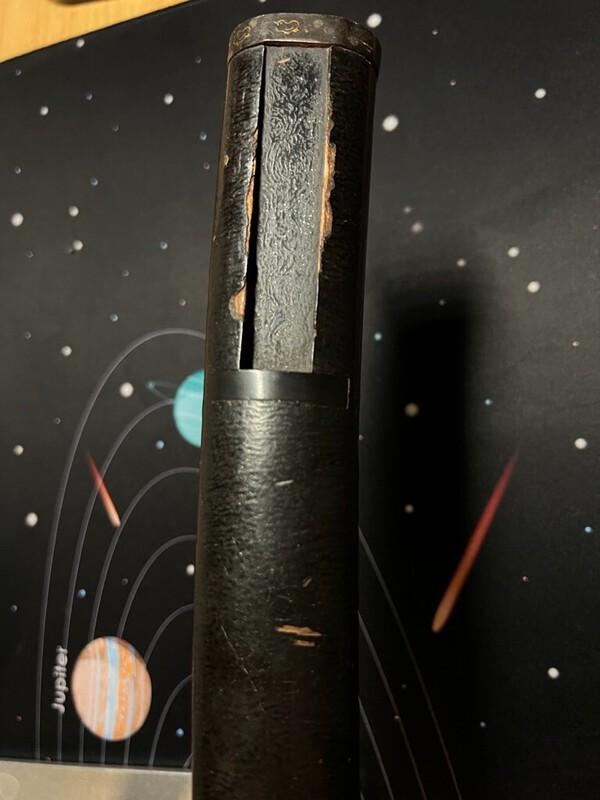
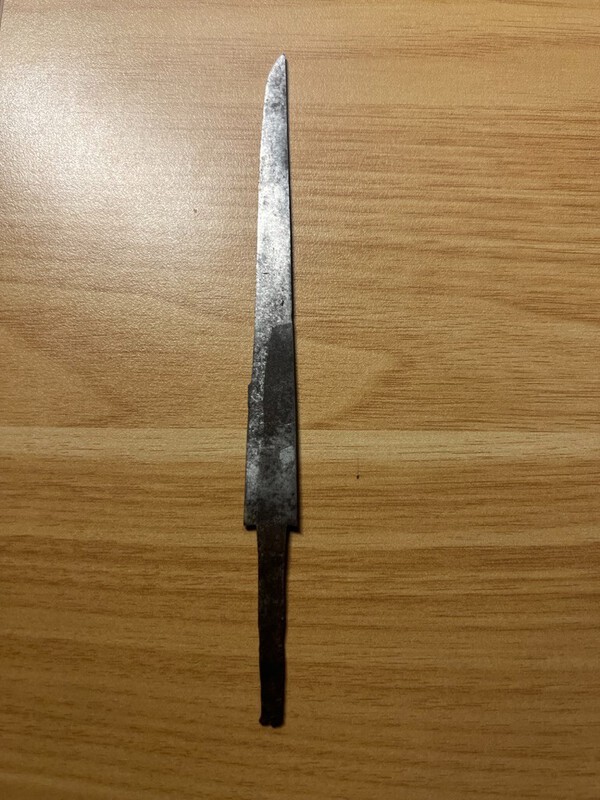
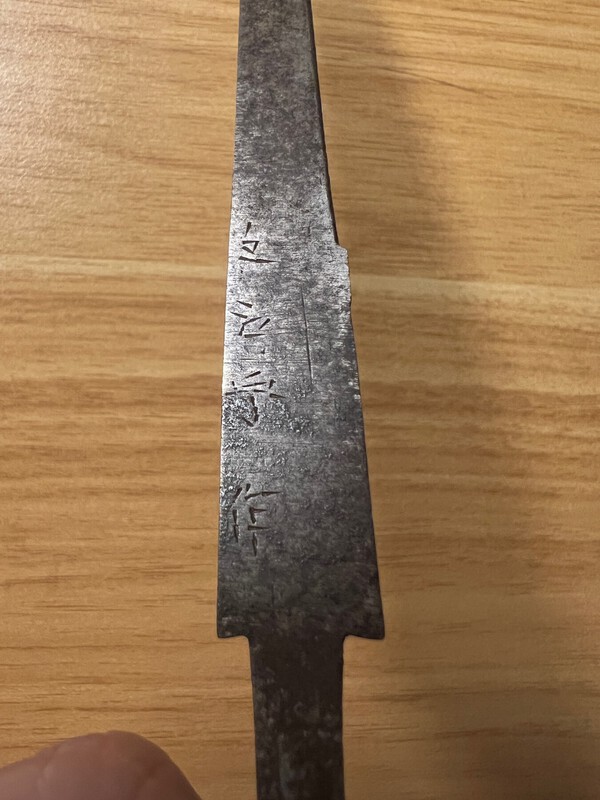

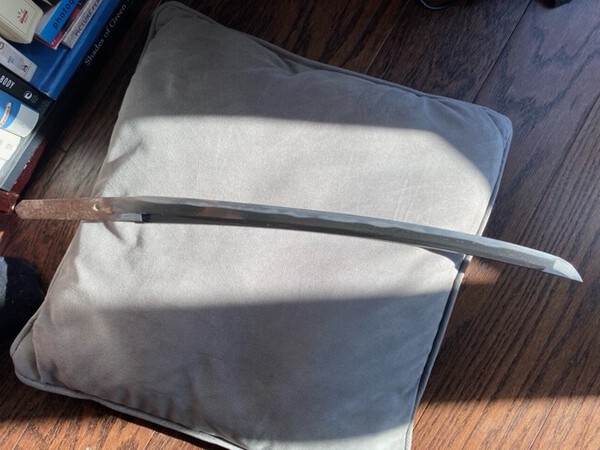
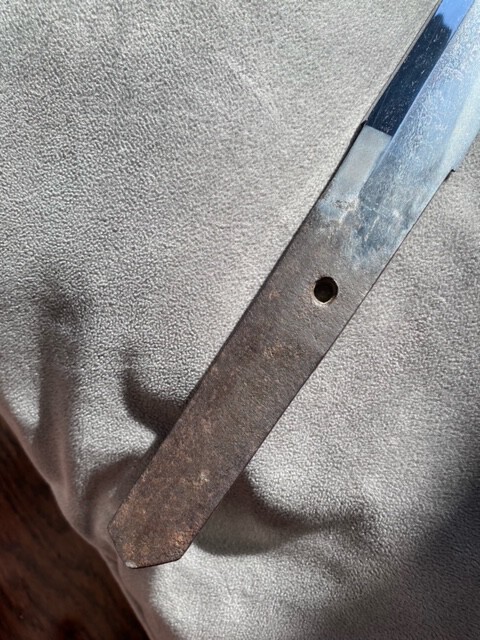













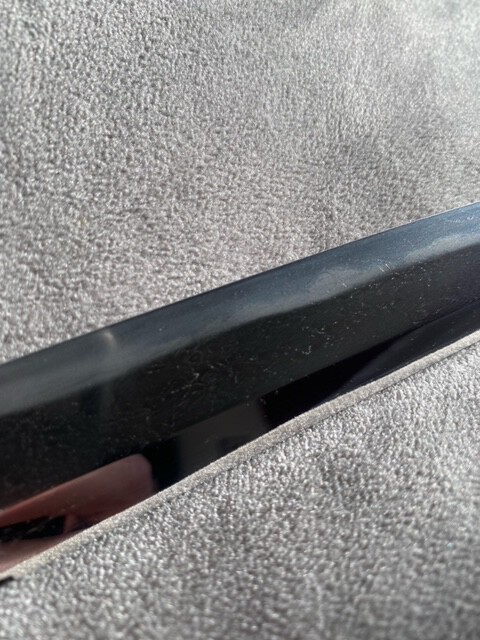






.thumb.jpeg.f552905beb0b54b9c8098abeaab5c44a.jpeg)
.thumb.jpeg.30da4ddb5f31b095b117df3ebacadc6d.jpeg)
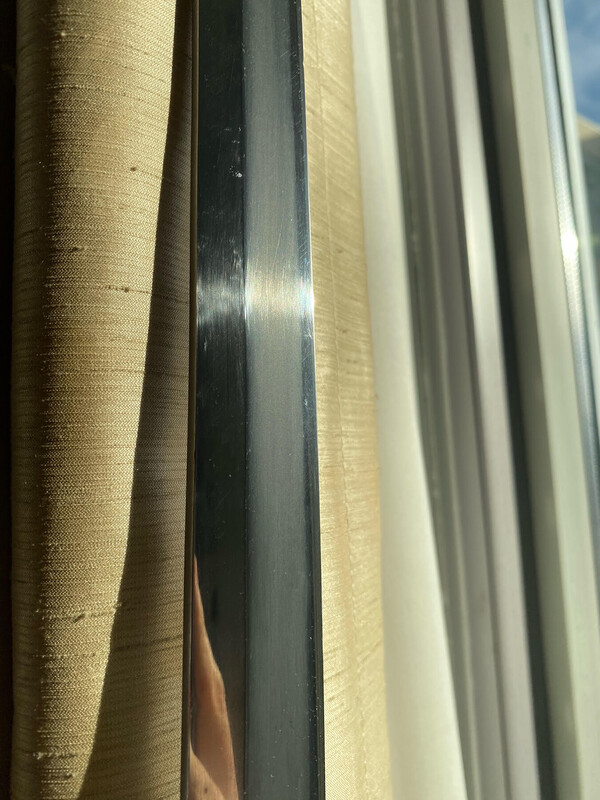

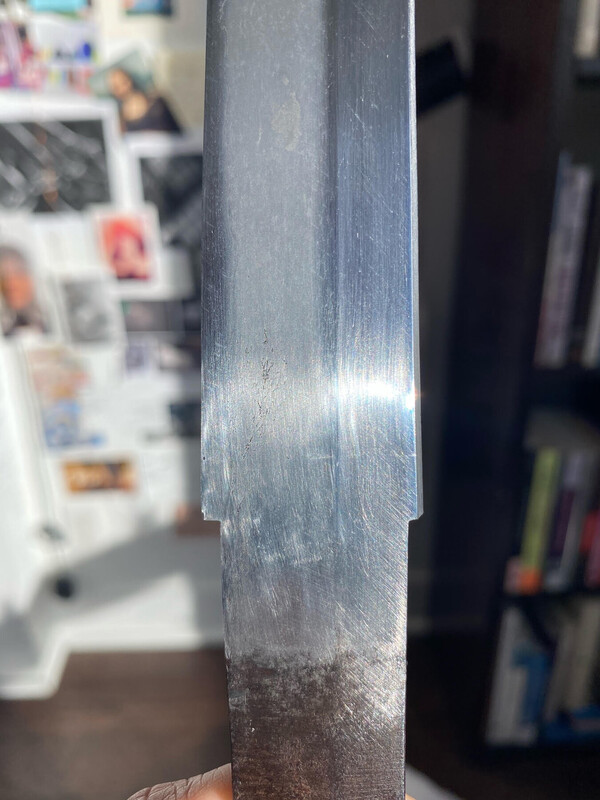






Tamashigiri , cutting test
in Nihonto
Posted
Congratulations Steve on your 2 body test cut katana - looks awesome.